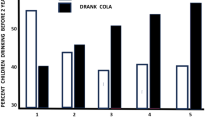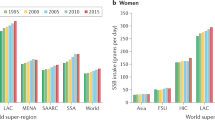Abstract
Aims:
The increasing prevalence of childhood obesity is a global problem. There are a variety of environmental factors that may be contributing to this increase. One such factor may be the increased consumption of soft drinks.
Objective:
This review will describe some of the latest research that has examined the association between obesity and the consumption of soft drinks.
Results:
The association between the consumption of sugar-sweetened drinks and childhood obesity has been established in three separate American studies. It has been found that children who consume these drinks have a higher energy intake and are more likely to become overweight. In adult women, the consumption of sugar-sweetened soft drinks has been associated with an increased risk of developing diabetes. In the United Kingdom, a school-based initiative focusing on reducing the consumption of these drinks has also been effective in preventing a further increase in obesity.
Conclusions:
There is an association between obesity and consumption of soft drinks. Initiatives focusing on reducing the consumption of these drinks may help to prevent a further increase in childhood obesity.
This is a preview of subscription content, access via your institution
Access options
Subscribe to this journal
Receive 12 print issues and online access
$259.00 per year
only $21.58 per issue
Buy this article
- Purchase on Springer Link
- Instant access to full article PDF
Prices may be subject to local taxes which are calculated during checkout
Similar content being viewed by others
References
Gill TP, Antipatis VJ, James WPT . The global epidemic of obesity. Asia Pacific J Clin Nutr 1999; 8: 75–81.
Jotangia D, Moody A, Stamatakis E, Wardle H . Health Survey for England: Obesity Among Children Under 11, Department of Health, Royal Free and University College Medical School, National Centre for Social Research: London; 2005.
Lissau I, Overpeak MD, Ruan J, Due P, Holstein BE, Hediger M . Body mass index and overweight in adolescents in 13 European countries, Israel, and the United States. Arch Pediatr Adolesc Med 2004; 158: 27–33.
Vanhala M, Vanhala P, Kumpusalo E, Halonen P, Takala J . Relation between obesity from childhood to adulthood and the metabolic syndrome: population based study. BMJ 1998; 317: 319.
Goran MI, Gower BA, Nagy TR, Johnson RK . Development changes in energy expenditure and physical activity in children: evidence for a decline in physical activity in girls before puberty. Pediatrics 1998; 101: 887–891.
National Institute for Health. Clinical Guidelines on the Identification, Evaluation and Treatment of Overweight and Obesity in Adults: The Evidence Report. National Institute of Health: Washington DC; 1998.
Hill JO, Peters JC . Environmental contributions to the obesity epidemic. Science 1998; 280: 1371–1374.
MacDonald's Corporation. http://www.mcdonalds.com/corp.html 2004, Ref Type: Electronic Citation.
Gregory J, Lowe S, Bates C, Prentice A, Jackson LV, Smithers G, Wenlock R, Farron M . National Diet and Nutrition Survey: young people aged 4 to 18 years. Volume 1: Report of the Diet and Nutrition Survey. The Stationary Office: London; 2000.
Putman JJ, Allshouse JE . Food Consumption, Prices and Expenditures, 1970–97. Food and consumers Economics, Division Economic Research Service, US Department of Agriculture: Washington, DC; 1999.
Block G . Foods contributing to energy intake in the US: data from NHANES III and NHANES 1999–2000. J Food Composition Anal 2004; 17: 439–447.
Harnack L, Stang J, Story M . Soft drink consumption among US children and adolescents: nutritional consequences. J Am Diet Assoc 1999; 99: 436–440.
Ludwig DS, Peterson KE, Gortmaker SL . Relation between consumption of sugar-sweetened drinks and childhood obesity: a prospective, observational analysis. Lancet 2001; 357: 505–508.
Mrdjenovic G, Levitsky DA . Nutritional and energetic consequences of sweetened drink consumption in 6–13-year old children. J Pediatr 2003; 142: 604–610.
Schulze MB, Manson JE, Ludwig DS, Colditz GA, Stamper MJ, Willett WC, Hu FB . Sugar-sweetened beverages, weight gain, and incidence of type 2 diabetes in young and middle-aged women. JAMA 2004; 292: 934.
Welsh JA et al. Overweight among low-income preschool children associated with consumption of sweet drinks: Missouri, 1999–2002. Pediatrics 2005; 115: 229.
James J, Thomas P, Cavan D, Kerr D . Preventing childhood obesity by reducing consumption of carbonated drinks: cluster randomised controlled trial. BMJ 2004; 328: 1237–1239.
Ebbeling C, Pawlak DB . Childhood obesity: public health crisis, common sense cure. Lancet 2002; 360: 473–482.
Hill J, Wyatt HR, Reed GW, Peters JC . Obesity and the environment: Where do we go from here? Science 2003; 299: 852–857.
Butte NF, Ellis KJ . Comment on ‘Obesity and the environment: where do we go from here?’. Science 2003; 301: 598.
Ludwig DS . Dietary glycemic index and obesity. Am Soc Nutr Sci 2000; 280S–283S.
Morris KL, Zemel MB . Glycemic index, cardiovascular disease, and obesity. Nutr Rev 1999; 57: 273–276.
Ludwig DS, Majzoub JA, Al-Zahrani A, Dallal GE, Blanoc I, Roberts SB . High glycemic index foods, overeating, and obesity. Pediatrics 1999; 103: 26–38.
Bellisle F, Rolland-Cachera M . How sugar-containing drinks might increase adiposity in children. Lancet 2001; 357: 490.
Apovian CM . Sugar-sweetened soft drinks, obesity and type 2 diabetes. JAMA 2004; 292: 978–979.
World Health Organization. Obesity: Preventing and Managing the Global Epidemic. Report of a WHO Consultation Presented at the World Health Organization, Geneva, Switzerland, WHO/NUT/NCD/98.1; 1997.
Fruhbeck G . Childhood obesity: time for action, not complacency. BMJ 2000; 320: 328–329.
Atkinson RL, Nitzke SA . School based programmes on obesity. BMJ 2001; 323: 1018–1019.
Author information
Authors and Affiliations
Corresponding author
Rights and permissions
About this article
Cite this article
James, J., Kerr, D. Prevention of childhood obesity by reducing soft drinks. Int J Obes 29 (Suppl 2), S54–S57 (2005). https://doi.org/10.1038/sj.ijo.0803062
Published:
Issue Date:
DOI: https://doi.org/10.1038/sj.ijo.0803062
Keywords
This article is cited by
-
Does the design of a soda tax matter? Evidence from school children in Europe
Empirical Economics (2023)
-
Effects of nutrition intervention strategies in the primary prevention of overweight and obesity in school settings: a protocol for a systematic review and network meta-analysis
Systematic Reviews (2021)
-
Long-term effects of adolescent obesity: time to act
Nature Reviews Endocrinology (2018)
-
A comparison of drinking behavior using a harmonized methodology (Liq.In 7 ) in six countries
European Journal of Nutrition (2018)
-
Exploring infant feeding practices: cross-sectional surveys of South Western Sydney, Singapore, and Ho Chi Minh City
BMC Pediatrics (2017)



